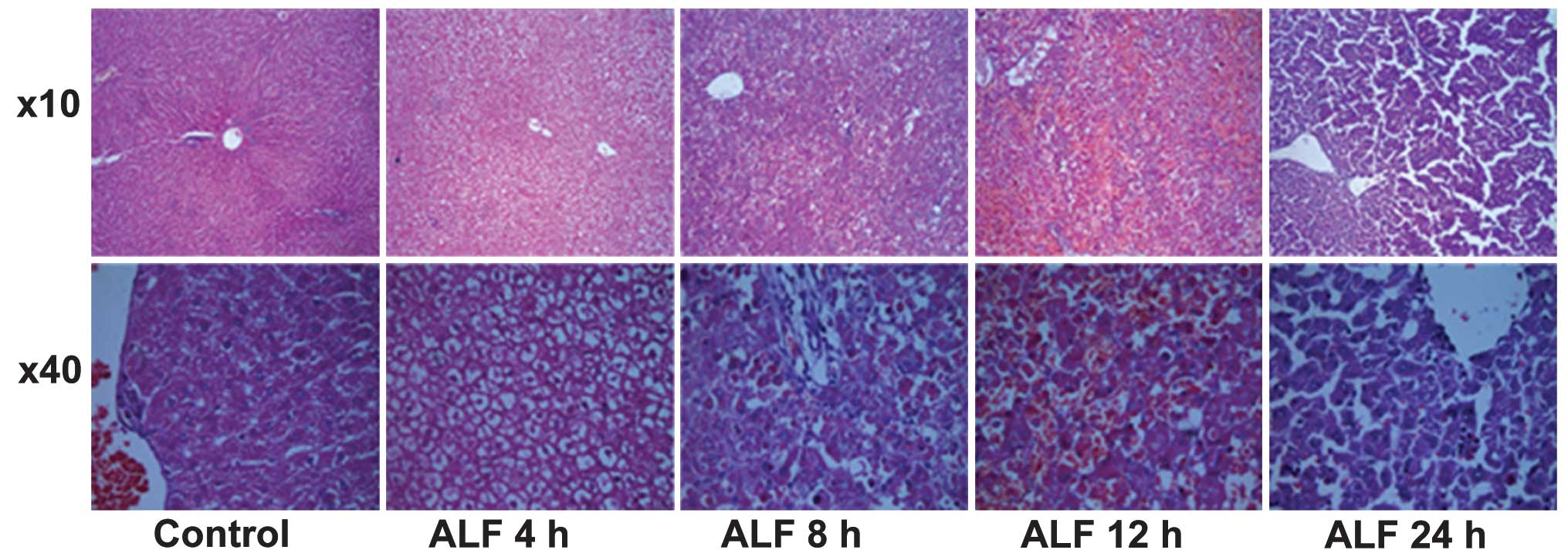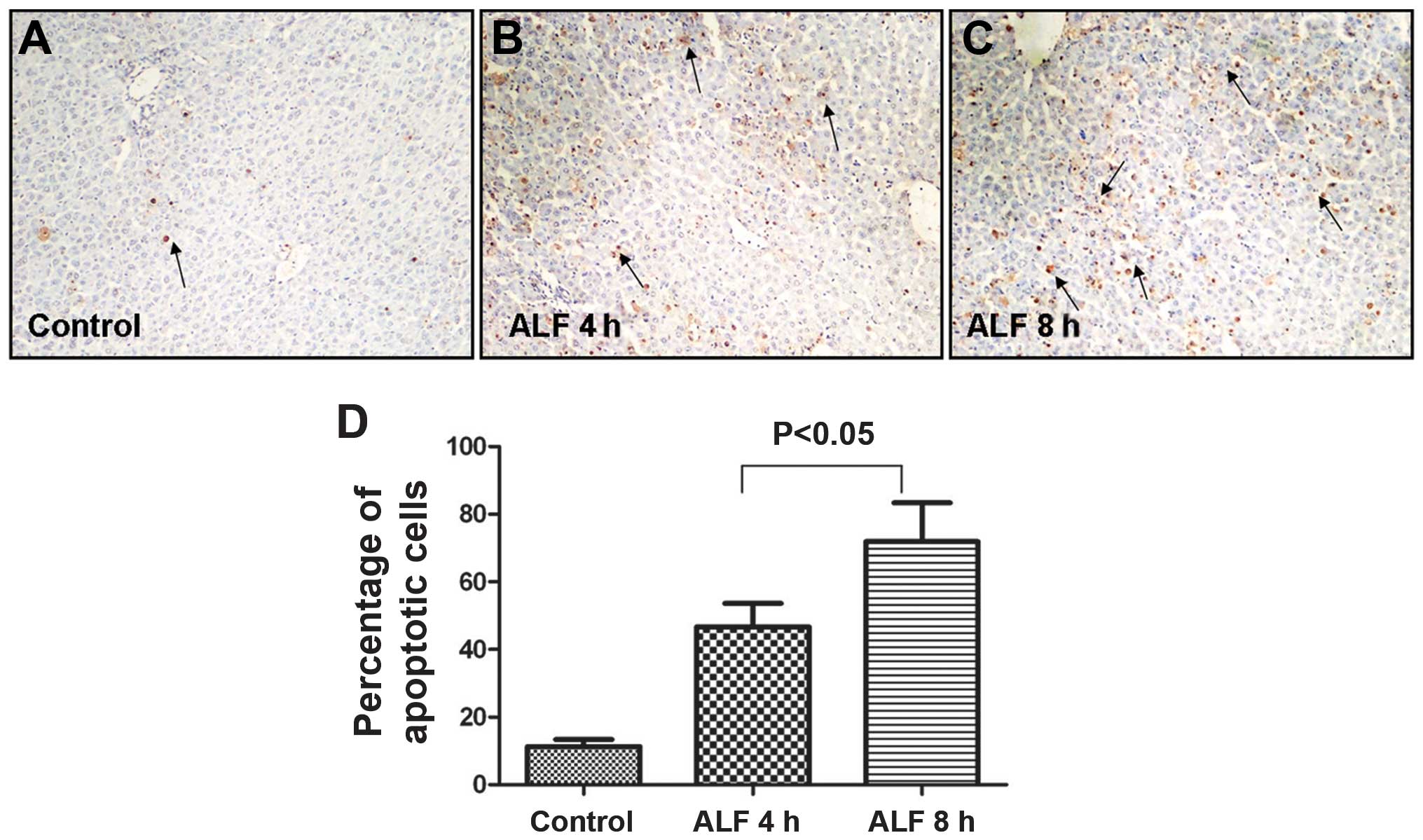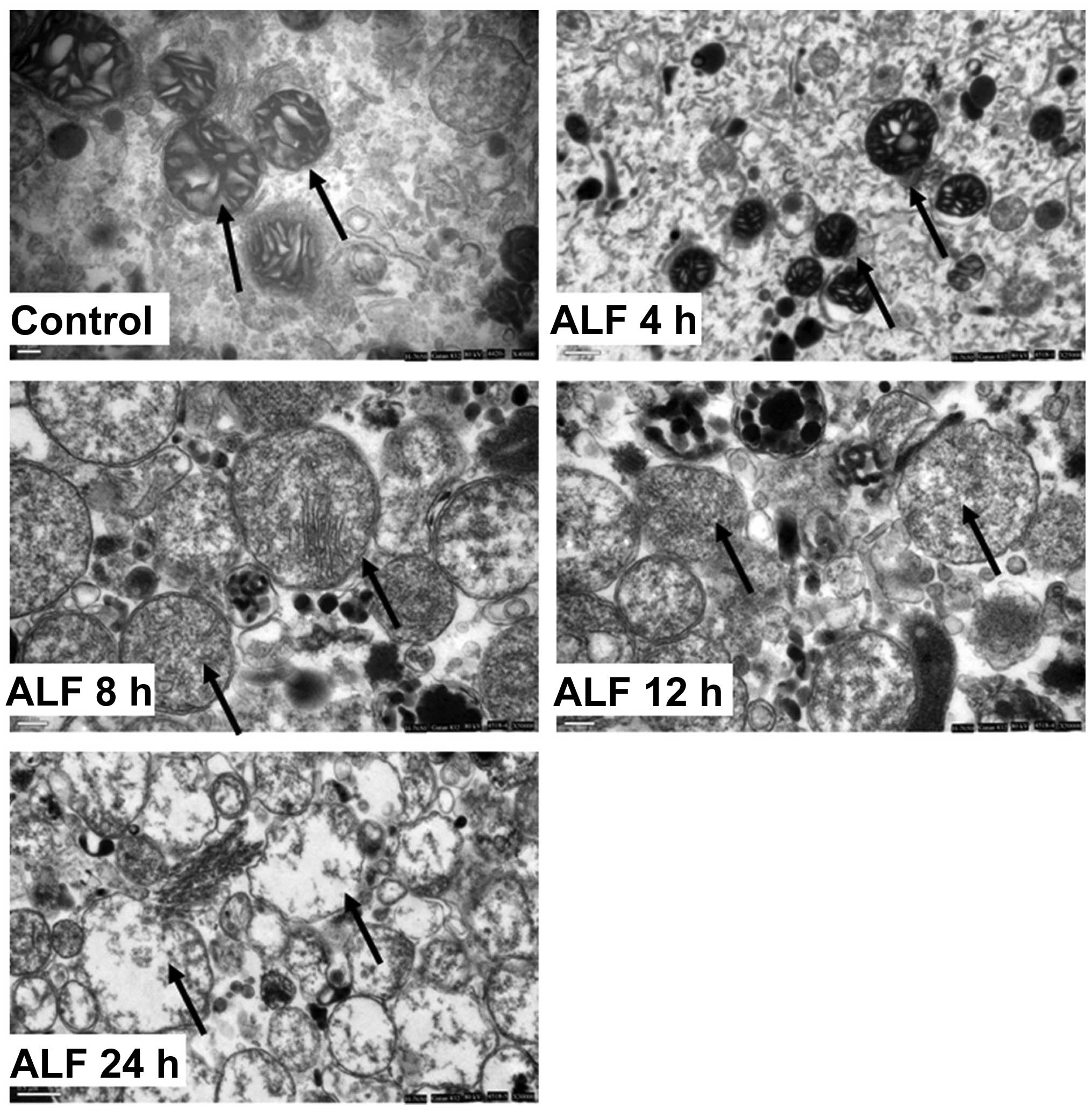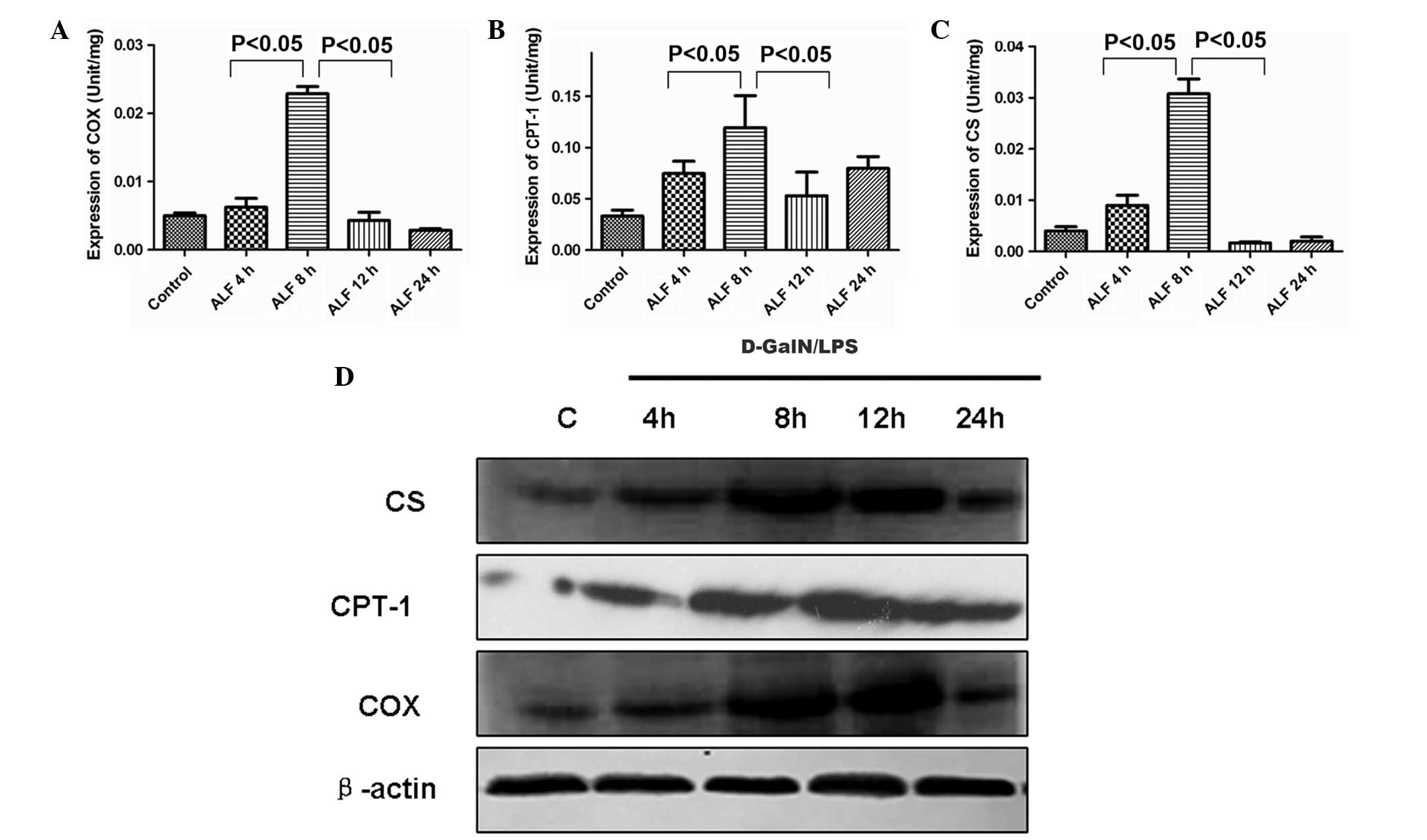|
1
|
Liver Failure and Artificial Liver Group;
Chinese Society of Infectious Diseases; Chinese Medical
Association; Severe Liver Diseases and Artificial Liver Group:
Chinese Society of Hepatology, Chinese Medical Association:
Diagnostic and treatment guidelines for liver failure. Zhonghua Gan
Zang Bing Za Zhi. 14:643–646. 2006.In Chinese.
|
|
2
|
Orrenius S: Reactive oxygen species in
mitochondria-mediated cell death. Drug Metab Rev. 39:443–455. 2007.
View Article : Google Scholar : PubMed/NCBI
|
|
3
|
Kushnareva Y and Newmeyer DD:
Bioenergetics and cell death. Ann NY Acad Sci. 1201:50–57. 2010.
View Article : Google Scholar : PubMed/NCBI
|
|
4
|
Ryu SY, Peixoto PM, Teijido O, Dejean LM
and Kinnally KW: Role of mitochondrial ion channels in cell death.
Biofactors. 36:255–263. 2010. View
Article : Google Scholar : PubMed/NCBI
|
|
5
|
Ohta S: A multi-functional organelle
mitochondrion is involved in cell death, proliferation and disease.
Curr Med Chem. 10:2485–2494. 2003. View Article : Google Scholar : PubMed/NCBI
|
|
6
|
Zhao BC: Role of liver in lipid
metabolism. Biochemistry (Chin). Zhou AR: 18. 5th edition. People's
Medical Publishing House; Beijing: pp. 3652003
|
|
7
|
Zhao BC: Regulation of activities of
enzymes. Biochemistry (Chin). Zhou AR: 4. 5th edition. People's
Medical Publishing House; Beijing: pp. 63–64. 2003
|
|
8
|
Wiegand G, Remington S, Deisenhofer J and
Huber R: Crystal structure analysis and molecular model of a
complex of citrate synthase with oxaloacetate and
S-acetonyl-coenzyme. A J Mol Biol. 174:205–219. 1984. View Article : Google Scholar
|
|
9
|
Cheng TL, Liao CC, Tsai WH, Lin CC, Yeh
CW, Teng CF and Chang WT: Identification and characterization of
the mitochondrial targeting sequence and mechanism in human citrate
synthase. J Cell Biochem. 107:1002–1015. 2009. View Article : Google Scholar : PubMed/NCBI
|
|
10
|
Donald LJ and Duckworth HW: Molecular
cloning of the structural gene for Acinetobacter citrate synthase.
Biochem Biophys Res Commun. 141:797–803. 1986. View Article : Google Scholar : PubMed/NCBI
|
|
11
|
Bloxham DP, Parmelee DC, Kumar S, Wade RD,
Ericsson LH, Neurath H, Walsh KA and Titani K: Primary structure of
porcine heart citrate synthase. Proc Natl Acad Sci USA.
78:5381–5385. 1981. View Article : Google Scholar : PubMed/NCBI
|
|
12
|
Kerner J and Hoppel C: Fatty acid import
into mitochondria. Biochim Biophys Acta. 1486:1–17. 2000.
View Article : Google Scholar : PubMed/NCBI
|
|
13
|
Ostermeier C, Iwata S and Michel H:
Cytochrome c oxidase. Curr Opin Struct Biol. 6:460–466. 1996.
View Article : Google Scholar : PubMed/NCBI
|
|
14
|
Kadenbach B, Barth J, Akgün R, Freund R,
Linder D and Possekel S: Regulation of mitochondrial energy
generation in health and disease. Biochim Biophys Acta.
1271:103–109. 1995. View Article : Google Scholar : PubMed/NCBI
|
|
15
|
Kadenbach B, Hüttemann M, Arnold S, Lee I
and Bender E: Mitochondrial energy metabolism is regulated via
nuclear-coded subunits of cytochrome c oxidase. Free Radic Biol
Med. 29:211–221. 2000. View Article : Google Scholar : PubMed/NCBI
|
|
16
|
Jezek P and Hlavatá L: Mitochondria in
homeostasis of reactive oxygen species in cell, tissues and
organism. Int J Biochem Cell Biol. 37:2478–2503. 2005. View Article : Google Scholar : PubMed/NCBI
|
|
17
|
Feldstein AE, Werneburg NW, Canbay A,
Guicciardi ME, Bronk SF, Rydzewski R, Burgart LJ and Gores GJ: Free
fatty acids promote hepatic lipotoxicity by stimulating TNF-alpha
expression via a lysosomal pathway. Hepatology. 40:185–194. 2004.
View Article : Google Scholar : PubMed/NCBI
|
|
18
|
Malhi H, Bronk SF, Werneburg NW and Gores
GJ: Free fatty acids induce JNK-dependent hepatocyte lipoapoptosis.
J Biol Chem. 281:12093–12101. 2006. View Article : Google Scholar : PubMed/NCBI
|
|
19
|
Turrens JF: Mitochondrial formation of
reactive oxygen species. J Physiol. 552:335–344. 2003. View Article : Google Scholar : PubMed/NCBI
|
|
20
|
Hsieh CL, Huang CN, Lin YC and Peng RY:
Molecular action mechanism against apoptosis by aqueous extract
from guava budding leaves elucidated with human umbilical vein
endothelial cell (HUVEC) model. J Agric Food Chem. 55:8523–8533.
2007. View Article : Google Scholar : PubMed/NCBI
|
|
21
|
Rana SV: Metals and apoptosis: Recent
developments. J Trace Elem Med Biol. 22:262–284. 2008. View Article : Google Scholar : PubMed/NCBI
|
|
22
|
Giordano A, Calvani M, Petillo O, Grippo
P, Tuccillo F, Melone MA, Bonelli P, Calarco A and Peluso G: tBid
induces alterations of mitochondrial fatty acid oxidation flux by
malonyl-CoA-independent inhibition of carnitine
palmitoyl-transferase-1. Cell Death Differ. 12:603–613. 2005.
View Article : Google Scholar : PubMed/NCBI
|
|
23
|
Harada H and Grant S: Apoptosis
regulators. Rev Clin Exp Hematol. 7:117–138. 2003.
|
|
24
|
Deutschman CS, Haber BA, Andrejko K,
Cressman DE, Harrison R, Elenko E and Taub R: Increased expression
of cytokine-induced neutrophil chemoattractant in septic rat liver.
Am J Physiol. 271:R593–R600. 1996.PubMed/NCBI
|
|
25
|
Decker K and Keppler D: Galactosamine
hepatitis: Key role of the nucleotide deficiency period in the
pathogenesis of cell injury and cell death. Rev Physiol Biochem
Pharmacol. 71:77–106. 1974. View Article : Google Scholar : PubMed/NCBI
|
|
26
|
Qiu Z, Kwon AH, Tsuji K, Kamiyama Y,
Okumura T and Hirao Y: Fibronectin prevents
D-galactosamine/lipopolysac-charide-induced lethal hepatic failure
in mice. Shock. 25:80–87. 2006. View Article : Google Scholar
|
|
27
|
Canbay A, Friedman S and Gores GJ:
Apoptosis: The nexus of liver injury and fibrosis. Hepatology.
39:273–278. 2004. View Article : Google Scholar : PubMed/NCBI
|
|
28
|
Malhi H, Gores GJ and Lemasters JJ:
Apoptosis and necrosis in the liver: A tale of two deaths?
Hepatology. 43(2 Suppl 1): pp. S31–S44. 2006, View Article : Google Scholar
|
|
29
|
Vaquero J and Blei AT: Etiology and
management of fulminant hepatic failure. Curr Gastroenterol Rep.
5:39–47. 2003. View Article : Google Scholar : PubMed/NCBI
|
|
30
|
Van Herreweghe F, Festjens N, Declercq W
and Vandenabeele P: Tumor necrosis factor-mediated cell death: To
break or to burst, that's the question. Cell Mol Life Sci.
67:1567–1579. 2010. View Article : Google Scholar : PubMed/NCBI
|
|
31
|
Davis CW, Hawkins BJ, Ramasamy S, Irrinki
KM, Cameron BA, Islam K, Daswani VP, Doonan PJ, Manevich Y and
Madesh M: Nitration of the mitochondrial complex I subunit NDUFB8
elicits RIP1- and RIP3-mediated necrosis. Free Radic Biol Med.
48:306–317. 2010. View Article : Google Scholar
|
|
32
|
Zhang DW, Shao J, Lin J, Zhang N, Lu BJ,
Lin SC, Dong MQ and Han J: RIP3, an energy metabolism regulator
that switches TNF-induced cell death from apoptosis to necrosis.
Science. 325:332–336. 2009. View Article : Google Scholar : PubMed/NCBI
|
|
33
|
Clemmesen O: Splanchnic circulation and
metabolism in patients with acute liver failure. Dan Med Bull.
49:177–193. 2002.PubMed/NCBI
|
|
34
|
Saibara T, Maeda T, Onishi S and Yamamoto
Y: Plasma exchange and the arterial blood ketone body ratio in
patients with acute hepatic failure. J Hepatol. 20:617–622. 1994.
View Article : Google Scholar : PubMed/NCBI
|
|
35
|
Lee SJ, Kwon CH and Kim YK: Alterations in
membrane transport function and cell viability induced by ATP
depletion in primary cultured rabbit renal proximal tubular cells.
Korean J Physiol Pharmacol. 13:15–22. 2009. View Article : Google Scholar : PubMed/NCBI
|
|
36
|
Zischka H, Larochette N, Hoffmann F,
Hamöller D, Jägemann N, Lichtmannegger J, Jennen L, Müller-Höcker
J, Roggel F, Göttlicher M, et al: Electrophoretic analysis of the
mitochondrial outer membrane rupture induced by permeability
transition. Anal Chem. 80:5051–5058. 2008. View Article : Google Scholar : PubMed/NCBI
|
|
37
|
Marín-García J, Goldenthal MJ, Damle S, Pi
Y and Moe GW: Regional distribution of mitochondrial dysfunction
and apoptotic remodeling in pacing-induced heart failure. J Card
Fail. 15:700–708. 2009. View Article : Google Scholar : PubMed/NCBI
|
|
38
|
Chinta SJ, Rane A, Yadava N, Andersen JK,
Nicholls DG and Polster BM: Reactive oxygen species regulation by
AIF- and complex I-depleted brain mitochondria. Free Radic Biol
Med. 46:939–947. 2009. View Article : Google Scholar : PubMed/NCBI
|
|
39
|
Puig T, Relat J, Marrero PF, Haro D,
Brunet J and Colomer R: Green tea catechin inhibits fatty acid
synthase without stimulating carnitine palmitoyltransferase-1 or
inducing weight loss in experimental animals. Anticancer Res.
28:3671–3676. 2008.
|
|
40
|
Mazzarelli P, Pucci S, Bonanno E, Sesti F,
Calvani M and Spagnoli LG: Carnitine palmitoyltransferase I in
human carcinomas: A novel role in histone deacetylation? Cancer
Biol Ther. 6:1606–1613. 2007. View Article : Google Scholar
|


















